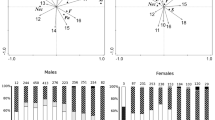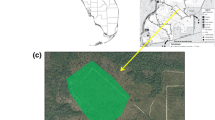Abstract
Gardens with nectar sources and larval host plants have been proposed to stem the decline in butterfly abundance caused by habitat loss. However, no study has provided evidence that gardens benefit butterflies. We examined the use of natural sites and gardens in the San Francisco bay area by the butterfly, Battus philenor. We found that natural sites were more likely to attract adult B. philenor, received more oviposition, and had higher juvenile survival than gardens sites. Butterflies were more likely to be present in gardens with established populations of the host plant, Aristolochia californica, growing in the sun. Battus philenor are unlikely to visit gardens with host plants planted within the past 7 years. Gardens between the ages of 8–40 years received oviposition, but did not always support completion of larval development of B. philenor. In gardens with host plants over 40 years of age, B. philenor consistently survived from egg to the adult stage. Natural enemy induced mortality of eggs did not differ between garden and natural sites, but overall egg survival was lower in gardens than at natural sites. It is unlikely that gardens serve as 'refugia' for B. philenor in years when populations in natural sites experience low survival or low fecundity. Even in gardens capable of supporting larvae to maturity, the density of eggs and survival rates were lower than in natural populations of the host plant suggesting that gardens were not optimal habitats. Therefore, without evidence that juvenile abundance and survival rates in gardens matches or exceeds that in natural sites, it is most likely that gardens act as population sinks for B. philenor.
Similar content being viewed by others
References
Blair R.B.and Launer A.E.1997.Butterfly diversity and hu-man land use:species assemblages along an urban gradient. Biol.Conserv.80:113–125.
Boggs C.L.1997a.Dynamics of reproductive allocation from juvenile and adult feeding:radiotracer studies.Ecology 78: 192–202.
Boggs C.L.1997b.Reproductive allocation from reserves and income in Butterfly species with differing adult diets.Ecology 78:181–191.
Connor E.F.and Taverner M.P.1997.The evolution and adaptive signi cance of the leaf-mining habit.Oikos 79:6–25.
Hafernik J.E.and Reinhard H.1995.Butterflies by the bay: winners and losers in San Francisco 's urban jungle.Am. Butterflies 3:4–11.
Hardy P.B.and Dennis R.L.H.1999.The impact of urban development on Butterflies within a city region.Biodiv. Conserv.8:1261–1279.
Holt R.D.1997.On the evolutionary stability of sink popula-tions.Evol.Ecol.11:723–731.
Marinelli J.1998.Stalking the Wild Amaranth:Gardening in the Age of Extinction.Henry Holt and Company, New York.
Mikula R.2000.The Family Butterfly Book:Projects,Activi-ties,and a Field Guide to 40 Favorite North American Species.Storey Books, Pownal,VA.
NABA.2002.Butterfly Gardens & Habitats.North American Butterfly Association, Morristown,NJ.<http://www.na-ba.org>,July 16,2004.
National Wildlife Federation.2002.Backyard Wildlife Habitat. National Wildlife Federation, Reston,VA.<http:// www.nwf.org/backyardwildlifehabitat/>,July 16,2004.
Peterson R.T.1996.Your Backyard Wildlife Year:How to Attract Birds,Butterflies,and Other Animals Every Month of the Year.Rodale Press Inc.,Emmaus,PA.
Pulliam R.1988.Sources,sinks,and population regulation. Am.Nat.132:652–661.
Rausher M.D.1978.Search image for leaf shape in a Butterfly. Science 200:1071–1073.
Rausher M.D.1980.Host abundance, juvenile survival, and oviposition preference in Battus philenor. Evolution 34:342–355.
Shapiro A.2002.The Californian urban Butterfly fauna is dependent on alien plants.Biodiv.Res.8:31–40.
Smittey D.R., Bauer L.S., Hajek A.E., Sapio F.J.and Humber R.A.1995.Introduction and establishment of Entomophaga maimaiga, a fungal pathogen of gypsy moth (Lepidoptera: Lymantriidae)in Michigan.Environ.Entomol.24:1685–1695.
Stokes D.W., Stokes L.Q.and Williams E.1991.The Butterfly Book:An Easy Guide to Butterfly Gardening,Identification, and Behaviour.Little,Brown and Company, Boston.
Swezey L.B.and Cohoon S.2002.Gardening for wildlife:your landscape can be a sanctuary for birds,Butterflies,and other lovely creatures.Sunset November:77–80.
Vickery M.1994.Butterfly conservation national garden but-terfly survey.Butterfly Conserv.News 59:26–28.
Vickery M.L.1995.Gardens:the neglected habitat.In:Pullin A.S.(ed.),Ecology and Conservation of Butterflies.Chap-man & Hall, London pp.123–134.
Vickery M.1996.The garden Butterfly survey 1995.Butterfly Conserv.News 62:25–27.
Vickery M.1998.Garden Butterfly survey 1997.Butterfly Conserv.News Spring 1998:26–28.
Vickery M.1999.Garden Butterfly survey 1989.Butterfly Conserv.News Spring/Summer 1999:24–26.
Weatherbee.2002.Gardening for Butterflies.National Audu-bon Society, NewYork.<http://magazine.audubon.org/ backyard/backyard.html>,July 16,2004.
Wood B.C.and Pullin A.S.2002.Persistence of species in a fragmented urban landscape:the importance of dispersal ability and habitat availability for grassland Butterflies.Bio-div.Conserv.11:1451–1468.
Zar J.H.1999.Biostatistical Analysis,4th ed.Prentice-Hall Inc., Upper Saddle River,NJ.
Author information
Authors and Affiliations
Rights and permissions
About this article
Cite this article
Levy, J.M., Connor, E.F. Are gardens effective in butterfly conservation? A case study with the pipevine swallowtail, Battus philenor . Journal of Insect Conservation 8, 323–330 (2004). https://doi.org/10.1007/s10841-004-0796-7
Issue Date:
DOI: https://doi.org/10.1007/s10841-004-0796-7




